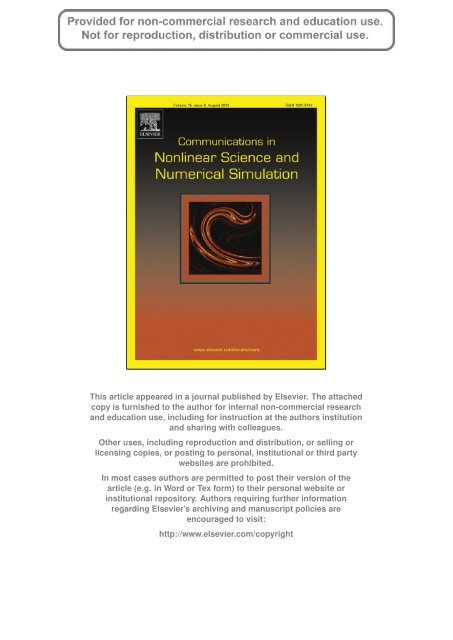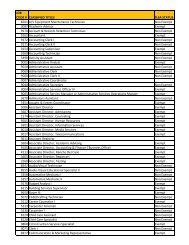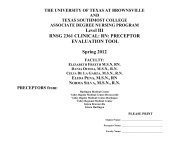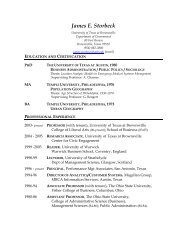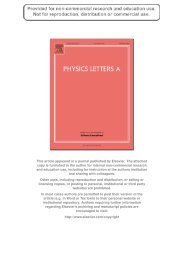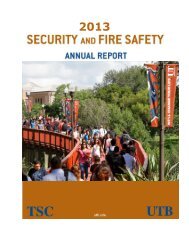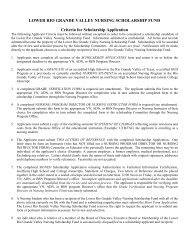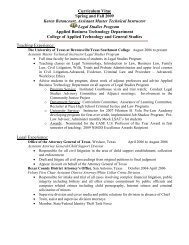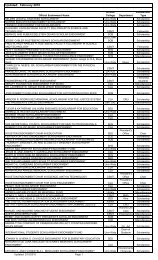beams_CNSNS1285
beams_CNSNS1285
beams_CNSNS1285
Create successful ePaper yourself
Turn your PDF publications into a flip-book with our unique Google optimized e-Paper software.
Author's personal copy1992 N.H. Ibragimov, R.N. Ibragimov / Commun Nonlinear Sci Numer Simulat 15 (2010) 1989–2002where b is the angle between the wavenumber vector and the horizontal (see Fig. 2). The dispersion relation (9) indicatesthat the frequency band is limited, i.e., x can change between the maximum of the buoyancy frequency N for the horizontalwavenumber vector (vertical motion) and the minimum of the inertial frequency f for the vertical wavenumber vector (horizontalmotion). The latter two cases represent two limiting cases of internal waves propagation.3. Symmetries and an invariant solutionBasic concepts from Lie group analysis of differential equations used in this paper are summarized in Appendix A.We will begin with considering invariant solutions provided by obvious symmetries of Eqs. (4)–(6), namely by the translationalsymmetriesX 1 ¼ o ot ; X 2 ¼ o ox ; X 3 ¼ o oz ; ð10Þand the following dilation generator:X 4 ¼ x o ox þ z o oz þ v oov þ q ooq þ 2w oow ;where the generators X i are defined by the formula (A8) in Appendix A.We will find the invariant solution based on the following two operators:mX 2 kX 3 ; X 4 ; ð12Þwhere k and m are scaling parameters representing the horizontal and vertical components of wavenumber vector. Theinvariants Jðt; x; z; v; q; wÞof the operators (12) are found by solving the equationsðmX 2 kX 3 ÞJ ¼ 0; X 4 J ¼ 0: ð13ÞThe characteristic equation kdx þ mdz ¼ 0 of the first equation in (13) yields that the operator mX 2 kX 3 has, along witht; v; q; and w, the following invariant:g ¼ kx þ mz:ð14ÞTo find the invariants Jðt; g; v; q; wÞ for the operator X 4 , we write the action of X 4 on the variables t; g; v; q; w by the standardformula (see e.g., formula (4.17) in Ibragimov [12])and obtainX 4 ¼ X 4 ðgÞ oog þ v oov þ q ooq þ 2w oowX 4 ¼ g oog þ v oov þ q ooq þ 2w oow :To solve the equation X 4 Jðt; g; v; q; wÞ ¼0 for the invariants, we calculate the first integrals for the characteristic systemdgg ¼ dv v ¼ dq q ¼ dw2wand see that a basis of invariants for the operators (12) is given byt; V ¼ v g ; R ¼ q g ; / ¼ w g 2 : ð18ÞAccordingly, we assign the invariants V; R and / to be functions of the invariant t and arrive at the following general form ofthe candidates for the invariant solutions:v ¼ gVðtÞ; q ¼ gRðtÞ; w ¼ g 2 /ðtÞ: ð19ÞIn order to find the functions VðtÞ; RðtÞ and /ðtÞ, we have to substitute the expressions (19) in the governing equations (4)–(6).We have:w t ¼ g 2 / 0 ðtÞ; w x ¼ 2kg/ðtÞ; w z ¼ 2mg/ðtÞ; ð20ÞD 2 w t ¼ 2j ~ kj 2 / 0 ðtÞ; D 2 w x ¼ 0; D 2 w z ¼ 0; ð21Þw x v z ¼ w z v x ¼ 2kmg/ðtÞVðtÞ;ð22Þw x q z¼ w z q x¼ 2kmg/ðtÞRðtÞð23ÞTherefore, Eqs. (4)–(6) yield the following system of first-order linear ordinary differential equations:ð11Þð15Þð16Þð17Þ
Author's personal copy1994 N.H. Ibragimov, R.N. Ibragimov / Commun Nonlinear Sci Numer Simulat 15 (2010) 1989–2002W 00W 0 ¼ G0G ¼ F0F ;ð43Þwe obtain Eq. (27). Then, according (28), we can set in (38) /ðtÞ ¼cosðxtÞ and /ðtÞ ¼sinðxtÞ, i.e.,w ¼ AðgÞ cosðxtÞ and w ¼ BðgÞ sinðxtÞ; ð44Þwhere AðgÞ and BðgÞ are arbitrary wave amplitudes of a superposition of plane waves, ðk; mÞ is the wavenumber vector lyingin the ðx; zÞ-plane at an angle a to the vertical and x is the wave frequency satisfying the dispersion relation (8). The latterresult showing that w given by (44) represents the exact non-linear solution to the inviscid equations of motion (4)–(6) followsfrom the fact that it solves the linear part of (2)–(4) while the non-linear convective-derivative terms in (4)–(6) areidentically zero (for the case f ¼ 0 and a single plane wave solution, this observation has also been discussed previouslyin Lombard and Riley [23]).For each w from (44) we determine the functions VðtÞ; RðtÞ using Eqs. (40) and (41), then take the linear combinations ofthe resulting functions and arrive at the following form of the ”generalized invariant solution” (38):w ¼ AðgÞ cosðxtÞþBðgÞ sinðxtÞ;u ¼ m½A 0 ðgÞ cosðxtÞþB 0 ðgÞ sinðxtÞŠ þ F 1 ðgÞ;ð45Þð46Þv ¼ fm x ½B0 ðgÞ cosðxtÞ A 0 ðgÞ sinðxtÞŠ þ F 2 ðgÞ; ð47Þw ¼ k½A 0 ðgÞ cosðxtÞþB 0 ðgÞ sinðxtÞŠ þ F 3 ðgÞ; ð48Þp ¼ m xk ðx2 f 2 Þ½AðgÞ sinðxtÞ BðgÞ cosðxtÞŠ þ F 4 ðgÞ; ð49Þq ¼ kN2gx ½B0 ðgÞ cosðxtÞ A 0 ðgÞ sinðxtÞŠ þ F 5 ðgÞ ð50Þwith arbitrary functions F i ðgÞ; i ¼ 1; 2; 3; 4; 5. In particular, the reckoning shows that the functions w; v; q given by (45), (47)and (50) with arbitrary F 2 ðgÞ and F 5 ðgÞ solve Eqs. (4)–(6) provided that the following equation holds:gkF 0 5 ðgÞþfmF0 2ðgÞ ¼0:ð51ÞOne can readily verify that the invariant solution (35)–(37), which is a particular case of (45), (47) and (50), obeys the condition(51). Thus, the set of the generalized invariant solutions (45)–(50) represents the complete set of exact solutions forfully nonlinear equations of motion (4)–(6).Since gravity provides a preferred direction (Tabaei and Akulas [30]), for any choice of AðgÞ and BðgÞ, the solutions (45)–(50) represent internal plane-wave <strong>beams</strong> in which energy propagates in one direction and consisting of sinusoidal planewave with wavenumber of the same sign only (the case of non-linear interactions between multi-directional monochromaticinternal waves with f ¼ 0 has been studied in Kistovich and Chasheschkin [19]).The presence of the invariant (14), g ¼ kx þ mz found by solving Eq. (13), ðmX 2 kX 3 ÞJ ¼ 0, indicates the remarkable factthat the translational symmetries X 2 and X 3 identify uniquely the direction of a general profile qffiffiffiffiffiffiffiffiffiffiffiffiffiffiffiffiffiffiffiffiffiffiffiffiffiffiffiffiffiffiffiffiffiffiffiffiffiffiffiffiffiffiof uniform plane waves propagatingin the transverse direction n ¼ kz xm and the frequency of oscillation x ¼ N 2 sin 2 b þ f 2 cos 2 b of the planewave<strong>beams</strong> depends only on the angle b between the g-direction and the horizontal (see Fig. 2).By taking the latter fact into account, we consider several analytic examples to give the interpretation of the generalizedinvariant solutions (45)–(50) as the internal plane-wave beam propagation satisfying a radiation condition.5. Two model examplesThere are many ways how internal waves in the ocean can be generated. For example, the oscillatory boundary conditionsforce the fluid particles to travel in the preferred direction of the wave ray. Another example is an oscillatory flow overtopography. In particular, time-harmonic wave <strong>beams</strong> radiating outwards from the topography with frequencies equal tothat of background flow have been studied in Bell [1], Khatiwala [20] and Ibragimov [15] under different flow and boundaryconditions and the topographic geometry. Within the framework of linear theory, the pressure field associated with theinternal wave solution of Eqs. (4)–(6) exerts a net force on the bottom topography. The resulting power input at the bottomis radiated vertically upward at the interior of the ocean and it is related to the vertical flux of energy, i.e., the wave beampropagates in a certain direction. Namely, the oscillatory flow over topography will generate wave <strong>beams</strong> propagating radiallyoutwards from the topography (see the results of the laboratory experiments shown in Fig. 1) at angles (see Fig. 2)a ¼cot 1 N 2 !1x 2 20x 2 0f 2ð52Þrelative to the horizontal, or
Author's personal copyN.H. Ibragimov, R.N. Ibragimov / Commun Nonlinear Sci Numer Simulat 15 (2010) 1989–2002 1995b ¼tan 1 N 2 !1x 2 20x 2 0f 2ð53Þrelative to the vertical, where x 0 is the frequency of the oscillating source or the frequency of the tidal flow ðx 0 ¼ x M2 Þ overa topography.We take the latter observation as the basis of two analytic examples which aim to show that the obtained generalizedinvariant solutions (45)–(50) represent the internal plane-wave <strong>beams</strong> satisfying the radiation condition, i.e., propagatingin the interior of the ocean in a preferred direction away from the source.For the sake of simplicity and in order to make our results comparable with the previous studies, we further set F i ðgÞ ¼0and we represent the invariant solution (45) in the equivalent formwðg; tÞ ¼QðgÞe ixt þ Q ðgÞe ixt ;ð54ÞwhereQðgÞ ¼ 1 ðAðgÞ iBðgÞÞ ð55Þ2and the * denotes the complex conjugate.Example 1. Initially, at t ¼ 0, it is givenwðg; 0Þ ¼a1 þ g ; ð56Þ2where a > 0 is a constant. Find the internal wave beam wðg; tÞ for t > 0 propagating upward to the right.Solution 1. Since the energy flux E is given by E ¼hupi ~ i x þhwpi ~ i z , where hi denotes the mean per unit wavelength, theenergy is radiated upward to the right if hupi and hwpi are both positive.Because of presentation of the invariant solution (45) in the form (54), it is convenient to write the initial condition (56)asZ 1 Z 0 Z 1wðg; 0Þ ¼ bQ ðsÞe is~ k~x ds ¼ bQ ðsÞe isg ds þ bQ ðsÞe isg ds;ð57Þ110where ~x ¼ðx; zÞ and ðg; nÞ can be written in terms of the angle a between the radiated energy and the horizontal asg ¼ x sin a z cos a; ð58Þn ¼ x cos a þ z sin a:ð59ÞThus, in terms of notation for g and n introduced by (58) and (59),bQ ðsÞ ¼Z 1QðgÞe isg dg1ð60Þin the presentation (57) denotes the Fourier transform of the initial condition for wðg; 0Þ, which represents an amount of energyradiated along the internal plane-wave beam at the angle a in the positive or negative n-direction, depending on thesign of s. The presence of the invariant g given by (58) allows to determine uniquely the direction of the beam propagationsatisfying the initial condition which, in more general case, can be written aswðg; 0Þ ¼QðgÞ:In particular, in view of four possible configurations of the group velocity ~c g given by~c g ¼ mN hj ~ ~ ix m ~ iikj 2 z k ; ð62Þð61Þand phase velocity ~c given by~c ¼ kN hj ~ ~ ix k þ ~ iikj 3 z mð63Þfor internal waves (see e.g., Tabaei et al. [31]), the radiation condition requires thatk > 0 and m < 0; ð64Þ(i.e., the wavenumber vector ~ k is directed downward to the right) for the energy to be radiated upward to the right. To choosethe sign of s, we use the presentation (57) for the initial condition at t ¼ 0 to write the invariant solution (54) as
Author's personal copy1996 N.H. Ibragimov, R.N. Ibragimov / Commun Nonlinear Sci Numer Simulat 15 (2010) 1989–2002wðg; tÞ ¼e ixt Z 11bQ ðsÞe isg ds þ e ixt Z 11bQ ðsÞe isg ds:ð65ÞWe further set x > 0. Since for any sinusoidal wave of the form hðxÞ ¼a sinðkx xtÞ, the phase velocity (63) can be writtenas ðx=k; x=mÞ, the sign of s is determined from the orthogonality of the group and phase velocity vectors ~c g and ~c for eachterm in the sum (65) as shown in the table below:The term in ð65Þ Phase velocity Sign of s ne i ð s~ k~x xtÞ ~c ¼ x ; xsk sjmj nð Þ ~c ¼ xs>0; ~c ge i s~ k~xþxtsk ;xsjmjs>0; ~c g is up to the rights 0 corresponds to the specified radiation condition, i.e., the energyradiates up and to the right. Substitution of Q b ðsÞ found by (70) into the general presentation of the solution (69) yieldswðg; tÞ ¼a r ffiffiffi Z p ffiffiffiffiffiffi2pe p 1ixt e s e isg ds þ c:c:;ð71Þ2 0where c:c. denotes the complex conjugate. Evaluating the integral in (71), we obtain the required solutionwðg; tÞ ¼ a 12 1 þ g þ i ge 2 1 þ g ixt þ a 1 gi e 2 2 1 þ g 2 1 þ g ixt ;2which also can be written in the form (45) aswðg; tÞ ¼aagcosðxtÞþ sinðxtÞ: ð73Þ1 þ g2 1 þ g2 As expected, setting t ¼ 0 in the both forms (72) and (73) yields the given initial condition (56).For illustrative purposes, Fig. 3 shows the initial distribution for pðg; 0Þ (which is found by (49) using the form (73) forwðg; tÞ) for different values of a at different values of the Earth’s latitude h. In present simulations we choose the frequencyof internal waves to be the M 2 tidal frequency, i.e., x ¼ x M2 ¼ 1:4075 10 4 ½s 1 Š which allows to associate the current modelwith the internal wave field generated by a barotropic tidal current oscillating with the M 2 tidal frequency. The scalingparameter a has been fixed: a ¼ 100. The buoyancy frequency was taken constant: N ¼ 10 3 rad=s. The Coriolis parameterwas taken f ¼ 1:27 10 5 rad=s ath ¼ 5 N (near the equator), f ¼ 7:29 10 5 [rad/s] at h ¼ 30 N, f ¼ 1:26 10 4 [rad/s]at h ¼ 60 N (mid-latitudes) and f ¼ 1:40 10 4 [rad/s] at h ¼ 74:2 N (near the critical latitude h 74:5 N for the M 2 constituent).The simulations were repeated for two different beam propagation angels, namely 10° and 30° to the horizontal.The question of particular interest was to observe the behaviour of solutions near the critical latitude h h (i.e., the latitudeat which the inertial frequency equals the M 2 frequency). At this critical latitude h , the theory for linear inviscid wavesbreaks down due to enhanced tidal mixing which is especially effective near this latitude. As Fig. 3 shows, the solutionsare evanescent when approach the critical latitude. In particular, as it is shown in panel (d) of Fig. 3, near the critical latitude,the solution changes its concavity. This situation is also illustrated in Fig. 6 presented in Section 6.Let us consider another example.Example 2. Initially, at t ¼ 0, it is givenwðg; 0; qÞ ¼a cosðqgÞ; ð74Þ1 þ g2 where q P 0 and a > 0 are constants. Find the internal wave beam wðg; tÞ for t > 0 propagating upward to the right.hð70Þð72Þ
Author's personal copyN.H. Ibragimov, R.N. Ibragimov / Commun Nonlinear Sci Numer Simulat 15 (2010) 1989–2002 1997a0.040.02b0.03α=10 oθ = 30 oα=10 o0.02α=30 o α=30 o0.01θ = 5 o -20 -10 0 10 2000-0.02-0.01-0.02-0.04-20 -10 0 10 20-0.03c0.010.005d-4x 102α=10 oθ = 74.2 oα=10 oα=30 o α=30 o1θ = 60 o -20 -10 0 10 2000-0.005-1-0.01-20 -10 0 10 20-2Fig. 3. Initial pressure distribution at different value of the Earth’s latitude h and the slops a ¼ 10 and a ¼ 30 of the energy radiation to the vertical.Solution 2. Note that the case q ¼ 0 corresponds to the internal wave beam studied in Example 1. Thus we want findwðg; t; qÞ satisfying the radiation condition and such thatwðg; t; 0Þ ¼aagcosðxtÞþ sinðxtÞ;1 þ g2 1 þ g2 ð75Þwðg; 0; 0Þ ¼a1 þ g : 2 ð76ÞWe denote wðg; 0; qÞ ¼Qðg; qÞ and follow the same procedure as in Example 1. The reckoning shows thatbQ ðsÞ ¼ pa2 fes q Hðq sÞþe q s Hðs qÞþe sþq Hð s qÞþe sþq Hðq þ sÞg; ð77Þwhere H is the Heavside function, e.g.,Hðq sÞ ¼ 1; s < q ; ð78Þ0; s > qwhere, again (according to the results shown in Table (66)), s > 0 is required to have the energy propagating up to the right.Substituting b Q ðsÞ calculated in (77) into the general presentation (69) and evaluating the corresponding integrals, we get therequired solutionwðg; q; tÞ ¼aacosðqgÞ cosðxtÞþ1 þ g2 1 þ g ½sinðqgÞþge q Š sinðxtÞ: ð79Þ2One can readily verify that the case t ¼ 0; q ¼ 0 in the solution (79) corresponds to the initial distribution (56) for wðg; 0Þconsidered in Example 1, the case t > 0; q ¼ 0 corresponds to the solution (75) which has also been obtained in Example1, and the case t ¼ 0; q > 0 corresponds to the given initial condition (74). As an alternative verification, direct substitutionof the obtained solution (79) into the form of the invariant solutions (46) and (49) for uðg; tÞ and pðg; tÞ and the reckoningshows that hupi > 0 and hupi > 0, so that the required radiation condition is satisfied, i.e., the energy is radiated upward topthe right. hFor illustrative and comparison purposes, Fig. 4 shows the analytic solution the pðg; q; 0Þ obtained from (49) and (79) forq ¼ 27 and the same values of parameters for beam propagation angles a, Earth’s latitude h, waves frequency x, scalingparameter a, and the buoyancy frequency N.
Author's personal copy1998 N.H. Ibragimov, R.N. Ibragimov / Commun Nonlinear Sci Numer Simulat 15 (2010) 1989–2002a0.10.05b0.06α=10 oθ = 30 oα=10 o0.04α=30 o α=30 o0.02θ = 5 o -10 -5 0 5 1000-0.05-0.02-0.04-0.1-10 -5 0 5 10-0.06c0.0150.010.005d-4x 104α=10 0θ = 74.2 oα=10 oα=30 o α=30 o2θ = 60 o -10 -5 0 5 1000-0.005-0.01-2-0.015-10 -5 0 5 10-4Fig. 4. Initial pressure distribution with q ¼ 27 at different value of the Earth’s latitude h and the slops a ¼ 10 and a ¼ 30 of the energy radiation to thevertical.Additionally, Fig. 5 shows the contour plot of the invariant solution wðg; q; 0Þ given by (79) for the same values of parametersas in Fig. 1 and a ¼ 30 .As for the case q ¼ 0, invariant solutions are evanescent near the critical latitude.6. ConclusionsApplication of Lie group analysis of differential equations shows that the nonlinear system of equations in geophysicalfluid dynamics (4)–(6) admits the translational and dilation symmetries. These two symmetries provide the exact solutions(45)–(50) to the equations of motion. The latter exact solutions have been deduced in previous studies from the anisotropicnature of internal wave propagation: frequency of plane waves depends only on the orientation of the wavenumber vector,but not on its magnitude. Due to this physical property, it is possible to construct a more general plane wave disturbances ofthe same frequency in the form of <strong>beams</strong> propagating in the direction n ¼ x sin a z cos a with a being the beam inclinationrelative to the horizontal (see e.g., Tabaei et al. [30,31] and Lombard and Riley [23]). Then the fact that the solutions (45)–(50) represent the exact solutions of fully nonlinear equations of motion follows from the observation that for a beam that isslowly modulated along the direction n and in time, the nonlinear effects due to modulation effects are cancel out.In this paper, we have shown that the beam-like solutions can be obtained by solving the original nonlinear Eqs. (4)–(6)by means of Lie group analysis. Furthermore, the obtained solutions (45)–(50) represent the particular set of invariant solutionsthat can be deduced from the infinite-dimensional algebra. In particular, the latter fact that the nonlinear terms for aslowly modulated beam cancel out, is evident from Eqs. (22) and (23) presented in Section 3. The point of particular interestin this paper was to show that the translational symmetries X 2 and X 3 provide the invariant solutions representing internalwave <strong>beams</strong> propagating in the direction transverse to the invariant g ¼ x cos a þ z sin a. The latter invariant is found as thesolution of linear partial differential equation ðmX 2 kX 3 ÞJ ¼ 0 which represents the determining equation defined by (A12).While the previous theoretical models of internal gravity wave <strong>beams</strong> are based either on the weakly nonlinear effects oron the smallness of beam amplitudes, Lie group analysis provides the exact solutions to the equations of motion without anyapproximation. In particular, this paper is devoted to the analysis of two particular sets of the invariant solutions which representinternal gravity wave <strong>beams</strong>.Analytic examples of uni-directional wave <strong>beams</strong> as invariant solutions are provided. In particular, Fig. 6 shows occurrenceof the concavity change of the initial distribution for pðg; 0Þ at the fixed value of the beam propagation anglea ¼ 10 N at different values h of the Earth’s latitude approaching the critical latitude h ! h . The question of particular inter-
Author's personal copyN.H. Ibragimov, R.N. Ibragimov / Commun Nonlinear Sci Numer Simulat 15 (2010) 1989–2002 199960504030201000 10 20 30 40 50 60Fig. 5. Contour plot of the solution for wðg; q; 0Þ in ðx; zÞ-plane showing the initial internal wave beem inclined at the angle of 30° to the horizontal x-axses.est in the forthcoming studies, is to employ Lie group analysis of differential equations to investigate the stability of internalwave <strong>beams</strong> with respect to small perturbations near the critical latitude, i.e., the latitude where the inertial frequencyequals the M 2 frequency, resulting in a strong depth-dependent tidal current. At this latitude, the enhanced tidal mixing occurand the linear inviscid theory of internal waves breaks down (Nigam and Held [25]). It is the fact that the Lie group ap-8 x 10-36α = 10 oθ = 65 o θ = 70 o4θ = 60 o20θ = 74.1 o-2-4-6-8-10 -8 -6 -4 -2 0 2 4 6 8 10Fig. 6. Inflection of invariant solution pðg; 0Þ near the critical latitude h 74:5 N.
Author's personal copy2000 N.H. Ibragimov, R.N. Ibragimov / Commun Nonlinear Sci Numer Simulat 15 (2010) 1989–2002proach does not require small-amplitude expansion (as it has been used in Tabaei at al. [31]) or the assumption on a slowlymodulated wave amplitudes (which has been employed, e.g., in Tabaei [30]). Instead, provided that the invariant solutions toEqs. (4)–(6) are known, the question on stability of internal wave <strong>beams</strong> can be studied in terms of stability of known symmetries.The latter question can be investigated by means of the recent theory of approximate symmetries of differentialequations with a small parameter (see Chapters 2 and 9 in Ibragimov [10]). The results of the forthcoming studies will bereported elsewhere.Appendix A. Outline of methods from Lie group analysisBasic concepts from Lie group analysis of differential equations used in this paper are assembled here. If the reader wantsto have more information about Lie groups and their applications in the theory of differential equations he has a big choice ofclassical and modern texts in this field, e.g., Lie [22], Cohen [5], Dickson [8], Ovsyannikov [27,28], Ibragimov [11], Olver [26],Bluman and Kumei [3], Stephani [29], Cantwell [4], Bluman and Anco [2].A concise introduction to the calculus of Lie symmetrygroups can be found in Chapter 1 of the Handbook [9] (see also Ibragimov [12]). The reader interested in applicationsof Lie groups in fluid dynamics can find a lot of information in the books by Ovsyannikov [27], Ibragimov [11,9] and Cantwell[4].Definition of one-parameter groups. Letz i ¼ f i ðz; aÞ; i ¼ 1; ...N; ðA1Þbe a one-parameter family of invertible transformations of points z ¼ðz 1 ; ...; z N Þ2R N into points z ¼ z 1 ; ...; z N 2 R N . Herea is a real parameter from a neighborhood of a ¼ 0, and we impose the condition that Transformation (A1) is an identity ifand only if a ¼ 0, i.e.,f i ðz; 0Þ ¼z i ; i ¼ 1; ...; N: ðA2ÞThe set G of transformations (A1) satisfying Condition (A2) is called a (local) one-parameter group of transformations in R N ifthe successive action of two transformations is identical to the action of a third transformation from G, i.e., if the functionf ¼ðf 1 ; ...; f N Þ satisfies the following group property:wheref i ðf ðz; aÞ; bÞ ¼f i ðz; cÞ; i ¼ 1; ...; N; ðA3Þc ¼ uða; bÞðA4Þwith a smooth function uða; bÞ defined for sufficiently small a and b. The group parameter a in the transformation (A1) can bechanged so that the function (A4) becomes c ¼ a þ b. In other words, the group property (A3) can be written, upon choosingan appropriate parameter a (called a canonical parameter) in the formf i ðf ðz; aÞ; bÞ ¼f i ðz; a þ bÞ:ðA5ÞGroup generator. Let G be a group of transformations (A1) satisfying the condition (A2) and the group property (A5).Expanding the functions f i ðz; aÞ into Taylor series near a ¼ 0 and keeping only the linear terms in a, one obtains the infinitesimaltransformation of the group G :z i z i þ an i ðzÞ;ðA6Þwheren i ðzÞ ¼ of i ðz; aÞoa ; i ¼ 1; ...; N: ðA7Þa¼0The first-order linear differential operatorX ¼ n i ðzÞ ooz iis known as the generator of the group G.Invariants. A function JðzÞ is said to be an invariant of the group G if for each point z ¼ðz 1 ; ...; z N Þ2R N is is constant alongthe trajectory determined by the totality of transformed points z : JðzÞ ¼JðzÞ.The function JðzÞ is an invariant of the group G with Generator (A8) if and only ifXðJÞ n i ðzÞ oJoz i ¼ 0:Hence any one-parameter group has exactly N 1 functionally independent invariants (basis of invariants). One can takethem to be the left-hand sides of N 1 first integrals J 1 ðzÞ ¼C 1 ; ...; J N 1 ðzÞ ¼C N 1 of the characteristic equations for linearpartial differential equation (A9). Then any other invariant is a function of J 1 ðzÞ; ...; J N 1 ðzÞ.ðA8ÞðA9Þ
Author's personal copyN.H. Ibragimov, R.N. Ibragimov / Commun Nonlinear Sci Numer Simulat 15 (2010) 1989–2002 2001Invariant equations. We say that a system of equationsF k ðzÞ ¼0; k ¼ 1; ...; s ðA10Þis invariant with respect to the group G (or admits the group G) if the transformations (A1) of the group G map any solution ofEq. (A10) into a solution of the same equations, i.e.,F k ðzÞ ¼0; k ¼ 1; ...; s ðA11Þwhenever z solves Eq. (A10). The group G with the generator (A8) is admitted by Eq. (A10) if and only ifXðF k Þj ðA10Þ¼ 0; k ¼ 1; ...; s; ðA12Þwhere the symbol j ðA10Þmeans evaluated on the solutions of Eq. (A10).If z is a collection of independent variables x ¼ðx 1 ; ...; x n Þ, dependent variables u ¼ðu 1 ; ...; u m Þ and partial derivatives n ou ð1Þ ¼ u a i ; uð2Þ ¼ u a ij; ...,ofu with respect to x up to certain order, whereu a i¼ ouaox i ;u a ij ¼ o2 u aox i ox j ; ...then (A10) is a system of partial differential equationsF k ðx; u; u ð1Þ ; ...Þ¼0; k ¼ 1; ...; s: ðA13ÞFurthermore, if the transformations (A1) are obtained by the transformations of the independent and dependent variablesx ¼ f ðx; u; aÞ; u ¼ gðx; u; aÞ ðA14Þand the extension of (A14) to all derivatives u ð1Þ , etc. involved in the differential equation (A13), then Eq. (A11) define a groupG of transformations (A14) admitted by the differential equation (A13). In other words, an admitted group does not changethe form of the system of differential equation (A13). The generator of the admitted group G is termed an infinitesimal symmetry(or simply symmetry) of the differential equation (A13). Eq. (A12) serve for obtaining the infinitesimal symmetries andare known as the determining equations. These equations are linear and homogeneous and therefore the set L of its solutionsis a vector space. Integration of determining equations often provides several linearly independent infinitesimal symmetries.Moreover, the determining equations have a specific property that guarantees that the set L is closed with respect to thecommutator ½X 1 ; X 2 Š¼X 1 X 2 X 2 X 1 . Due to this property L is called a Lie algebra. If the dimension of the vector space L isequal to r, the space is denoted by L r and is called an r-dimensional Lie algebra. An r-dimensional Lie algebra L r generatesa group depending on r parameters which is called an r-parameter group.Invariant solutions. Let the differential equation (A13) admit a multi-parameter group G, and let H be a subgroup of G. Asolutionu a ¼ h a ðxÞ; a ¼ 1; ...; m ðA15Þof Eq. (A13) is called an H invariant solution (termed for brevity an invariant solution) if Eq. (A15) are invariant with respectto the subgroup H. IfH is a one-parameter group and has the generator X, then the H-invariant solutions are constructed bycalculating a basis of invariants J 1 ; J 2 ; .... The procedure has been clearly described in Section 3 (Eqs. (18) and (19)).References[1] Bell TH. Lee waves in stratified flows with simple harmonic time dependence. J Fluid Mech 1975;67:705–22.[2] Bluman GW, Anco SC. Symmetry and integration methods for differential equations. New York: Springer; 2002.[3] Bluman GW, Kumei S. Symmetries and differential equations. New York: Springer; 1989.[4] Cantwell BJ. Introduction to symmetry analysis. Cambridge: Cambridge University Press; 2002.[5] Cohen A. An introduction to the Lie theory of one-parameter groups with applications to the solution of differential equations. New York: D.C. Heath;1911.[6] Dalziel SB, Hughes GO, Sutherland BR. Whole field density measurements by synthetic schlieren. Exp Fluids 2000;28:322–37.[7] Dauxois T, Young WR. Near-critical reflection of internal waves. J Fluid Mech 1999;390:271–95.[8] Dickson LE. Differential equations from the group standpoint. Ann Math 1924;25:287.[9] Ibragimov NH, editor. CRC handbook of lie group analysis of differential equations. Applications in engineering and physical sciences, vol. 2. Boca Raton(FL): CRC Press; 1995.[10] Ibragimov NH, editor. CRC handbook of lie group analysis of differential equations. New trends in theoretical development and computationalmethods, vol. 3. Boca Raton (FL): CRC Press; 1996.[11] Ibragimov NH. Transformation groups applied to mathematical physics. Moscow: Nauka; 1983. English transl., Dordrecht: Reidel; 1985.[12] Ibragimov NH. Elementary Lie group analysis and ordinary differential equations. Chichester: Wiley; 1999.[13] Ibragimov RN. Resonant triad model for studying evolution of the energy spectrum among a large number of internal waves. Commun Nonlinear SciNumer Simul 2008;13:593–623.[14] Ibragimov RN. Oscillatory nature and dissipation of the internal waves energy spectrum in the deep ocean. Eur Phys J 2007;40:315–34.[15] Ibragimov RN. Generation of internal tides by an oscillating background flow along a corrugated slope. Phys Scripta 2008;78:065801.[16] Ibragimov RN. Stationary surface waves in a circular liquid layer with constant gravity. Quest Math 2000;23(1):1–12.[17] Ibragimov RN. Shallow water theory and solution of the problem on the atmospheric motion around a celestial body. Phys Scripta 2000;61:391–5.[18] Javam A, Imberger J, Armfield SW. Numerical study of internal wave-wave interactions in a stratified fluid. J Fluid Mech 2000;415:65–87.[19] Kistovich AV, Chashechkin YD. Nonlinear interactions of two dimensional packets of monochromatic internal waves. Izv Atmos Ocean Phys1991;27(12):946–51.
Author's personal copy2002 N.H. Ibragimov, R.N. Ibragimov / Commun Nonlinear Sci Numer Simulat 15 (2010) 1989–2002[20] Khatiwala S. Generation of internal tides in an ocean of finite depth: analytical and numerical calculations. Deep-See Res I 2003;50:3–21.[21] Lam FP, Mass LM, Gerkema T. Spatial structure of tidal and residual currents as observed over the shelf break in the Bay of Biscay. Deep-See Res I2004;51:10751096.[22] Lie S. Vorlesungen uber Differentialgleichungen Mit Bekannten Infinitesimalen Transformationen. (Bearbeited und herausgegeben von Dr. G.Scheffers), B.G. Teubner, Leizig. 1891.[23] Lombard PN, Riley J. On the breakdown into turbulence of propagating internal waves. Dyn Atmos Oceans 1996;23:345–55.[24] Nash JD, Kunze E, Lee CM, Sanford TB. Structure of the baroclinic tide generated at Keana Ridge, Hawaii. J Phys Oceanogr 2006;36:1123–35.[25] Nigam S, Held I. The influence of a critical latitude on topographically forced stationary waves in a barotropic model. J Atmos Sci 1983;40:554–71.[26] Olver PJ. Applications of Lie groups to differential equations. New York: Springer; 1986.[27] Ovsyannikov LV. Group properties of differential equations Siberian branch. Novosibirsk: USSR Academy of Sciences; 1962.[28] Ovsyannikov LV. Group analysis of differential equations. Moscow: Nauka; 1978. English transl., Ames WF, editor. New York: Academic Press; 1982.[29] Stephani H. Differential equations: their solution using symmetries. Cambridge: Cambridge University Press; 1989.[30] Tabaei A, Akylas TR. Nonlinear internal gravity wave <strong>beams</strong>. J Fluid Mech 2003;482:141–61.[31] Tabaei A, Akylas TR, Lamb K. Nonlinear effects in reflecting and colliding internal wave <strong>beams</strong>. J Fluid Mech 2005;526:217–43.[32] Teoh SG, Imberger J, Ivey GN. Laboratory study of the interactions between two internal wave rays. J Fluid Mech 1997;336(91).


